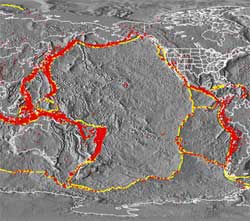The Famous Ring of Fire
 Courtesy USGS. The large Pacific Plate underlies the Pacific Ocean. Its margins include mid-oceanic ridges, where the crust is growing,subduction,zones, where one plate is riding over another, and zones where plates are moving past each other. The overall result is the most seismically active area of the world, with extensive volcano and earthquake activity. Because of this, the region has been dubbed the Ring of Fire. |
When it comes to producing volcanoes, the Pacific Ocean has it all: hot spots, mid-ocean ridges where plates diverge, and a ring of subduction zones around its edges. Besides being the biggest ocean, the Pacific sits on the Earth’s biggest oceanic plate, the Pacific Plate. This mammoth raft moves relatively quickly (for a tectonic plate) toward Asia. The faster a plate moves, the more magma chambers—and volcanoes—it creates at rifts and subduction zones.
|
The colors in this map make it easy to see the different plates of the Earth's crust. |
Smaller oceanic plates (Nazca, Philippine, Juan de Fuca, and others) border the continents—South America, Asia, and North America. These plates are moving in different directions than the Pacific Plate, creating more rifts and more subduction zones. All this plate movement has resulted in frequent earthquakes and many active volcanoes. Thus the area around the Pacific Plate has been dubbed the “Ring of Fire.”
Here are the results of all this tectonic movement, by the numbers:
- Of the roughly 600 land volcanoes that have erupted in recorded history, two out of three border the Ring of Fire at subduction zones.
- In addition to those 600, several thousand more land volcanoes could potentially erupt and most of these, too, have Pacific addresses.
- About 50,000—and counting—undersea volcanoes have been identified on the Pacific Ocean floor at rifts. Their eruptions are difficult to identify and monitor.
Given the number of active volcanoes on the Earth, an interesting question is: Why don’t volcanoes erupt all the time?
|
|
|
 |
Digging DeeperFind out more about |
|
|
|
This content has been re-published with permission from SEED. Copyright © 2025 Schlumberger Excellence in Education Development (SEED), Inc.


